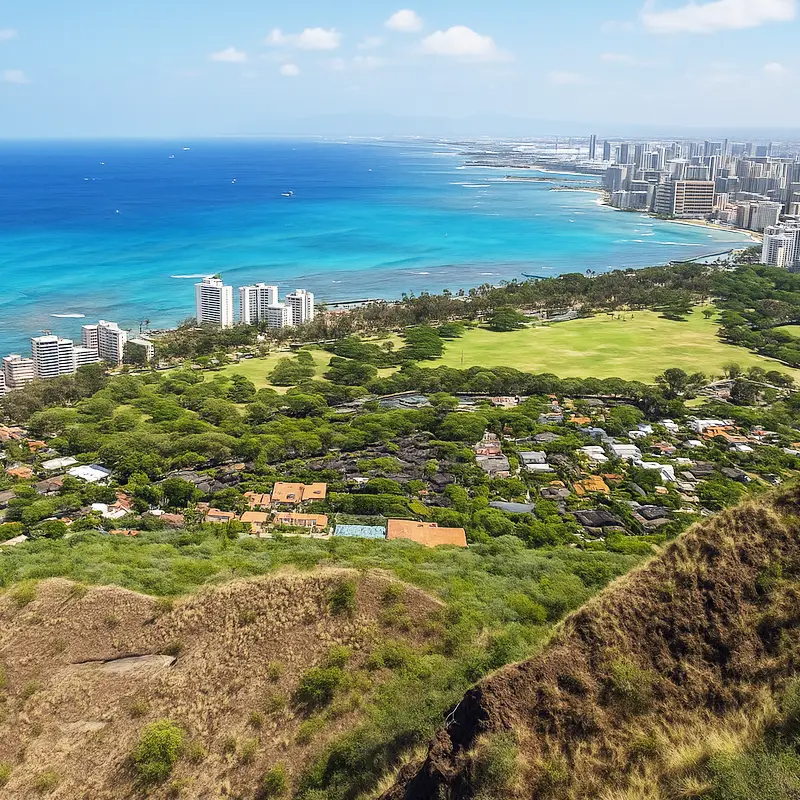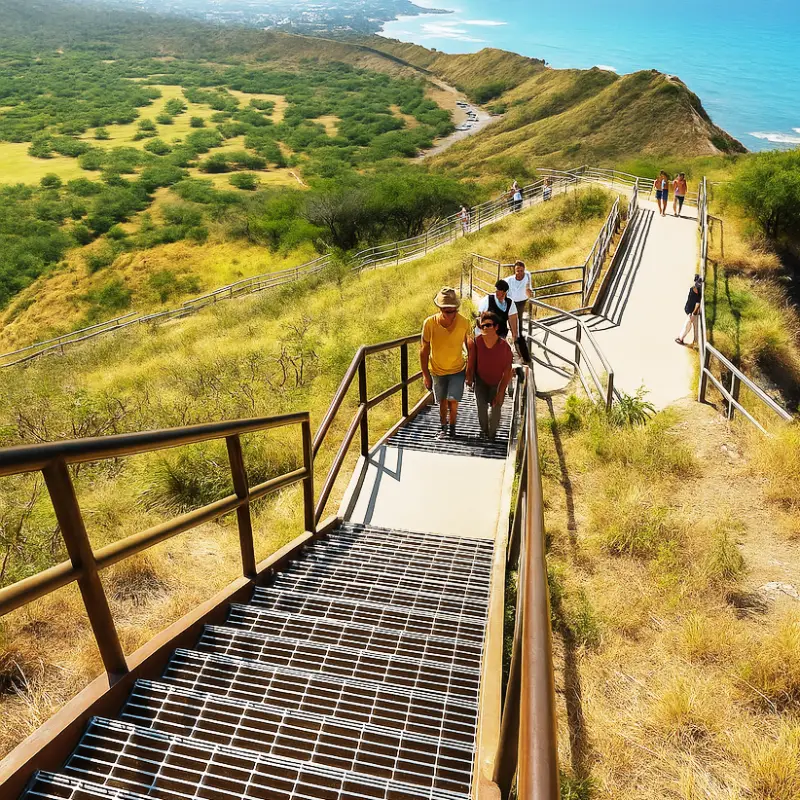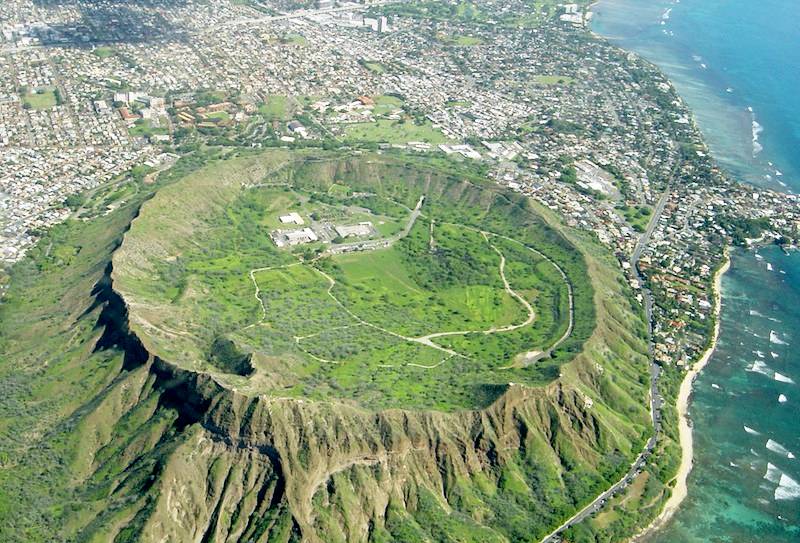Diamond Head is one of Hawaii’s most famous landmarks – a volcanic crater that rises dramatically above the eastern edge of Waikīkī. Known for its sweeping coastal views, rich military history, and challenging summit trail, it’s no wonder more than 3,000 people visit every day. Whether you’re in Oʻahu for a few days or a few weeks, a hike up Diamond Head State Monument is a must-do experience.
Quick Facts
- Location: Eastern Waikīkī coastline, Oʻahu
- Size: 475 acres (interior + outer slopes of the crater)
- Trail Name: Diamond Head Summit Trail
- Trail Length: 0.8 miles one way (1.6 miles round trip)
- Elevation Gain: 560 feet
- Difficulty: Strenuous but short
- Time Required: 1.5–2 hours round trip
Diamond Head State Monument sits on the eastern edge of Waikīkī, just a short drive from Honolulu, and is one of the island’s most recognizable landmarks. The park spans 475 acres, covering both the wide crater floor and the outer slopes formed by a single volcanic eruption nearly 300,000 years ago. The main route here is the Diamond Head Summit Trail, a historic path built in 1908 as part of Oʻahu’s military defense system.

Although the hike is only 0.8 miles one way (1.6 miles round trip), it climbs 560 feet from the crater floor to the summit. The trail includes switchbacks, steep stairways, and even a lighted tunnel, making it short but strenuous. Most people with average fitness can complete it without difficulty, though you should expect uneven terrain and little shade along the way. On average, allow 1.5 to 2 hours for the round trip, giving yourself time to rest at the top and enjoy the incredible panoramic views over Waikīkī, Koko Head, and the Wai‘anae Range. For the best experience, go early in the morning to avoid crowds and midday heat.
Park Hours & Reservations
Diamond Head is open every day from 6:00 am to 6:00 pm, but here’s the catch — the last entry is at 4:30 pm sharp. That’s because the gates lock right at 6:00 pm, and everyone has to be out of the park by then. So if you’re planning a late afternoon hike, make sure you give yourself enough time to get up, enjoy the views, and come back down before closing. Also note: the park is closed on Christmas Day and New Year’s Day.
Another thing to keep in mind: if you’re a non-resident, you can’t just show up anymore. As of May 2022, reservations are required for both entry and parking. It’s super easy to book online, and it guarantees your spot (which is important since Diamond Head gets really busy). Locals with a Hawaii ID can enter for free and don’t need a reservation, but visitors definitely need to plan ahead.
If you’re the type who loves early mornings, grabbing one of the first reservation slots of the day is the best move. The hike is cooler, the trail is quieter, and the lighting for photos at the top is unbeatable.
Entrance Fees
Getting into Diamond Head is pretty simple – but make sure you’ve got a credit card with you because that’s the only form of payment accepted.
- Hawaiʻi Residents: Free! Just show your valid Hawaiʻi ID or driver’s license at the gate.
- Non-Residents: $5 per person. Kids 3 and under get in free, so little ones can tag along without charge.
It’s a small fee considering you’re hiking one of the most iconic craters in the world, and honestly, the views from the top are worth way more than the price of admission. Just don’t forget to book your reservation online if you’re visiting from out of state, since you can’t pay at the gate without one.
Parking Fees
If you’re driving up to Diamond Head, you’ll also need to cover parking (again, credit card only). Here’s how it breaks down:
- Hawaiʻi Residents: Free parking with a local ID.
- Non-Residents: $10 per vehicle.
- Commercial vehicles: Rates vary depending on size — $25 for small vans (1–7 passengers), $50 for mid-size (8–25 passengers), and $90 for large buses (26+ passengers).
Parking spots can fill up quickly, especially mid-morning, so if you’re driving, it’s smart to book an early slot when you make your reservation. Not only do you snag a space, but you’ll also beat the heat and the biggest crowds on the trail.
The Diamond Head Summit Trail

The Diamond Head Summit Trail may be short, but it packs a punch. At just under a mile one way, it’s a hike that combines steep climbs, cool history, and some of the best views you’ll find anywhere on Oʻahu.
The trail was first built back in 1908 as part of the island’s coastal defense system. You’ll actually be walking the same path that soldiers once used to reach bunkers and lookouts high above Waikīkī. It starts off easy with a concrete walkway, but after about 0.2 miles the surface changes to natural tuff rock — the volcanic material that formed the crater during a single explosive eruption 300,000 years ago.
From there, things get more challenging. You’ll wind your way up tight switchbacks, climb steep staircases, and pass through a 225-foot tunnel (yes, it’s lit, but it still feels like a little adventure). Near the top, you’ll enter the Fire Control Station, built in 1911 to help direct coastal artillery.
Once you finally step out at the summit, you’re rewarded with a mix of history and jaw-dropping scenery. You’ll see old military bunkers, the Diamond Head Lighthouse (built in 1917 and still in use), and sweeping views of Oʻahu’s southern coastline. On a clear day, you can spot Koko Head to the east, the Wai‘anae Range to the west, and endless blue stretching out across the Pacific. Visit in the winter months and you may even catch sight of humpback whales cruising through the Kaiwi Channel.
It’s a tough climb, but the sense of accomplishment — and those postcard views — make it one of the most unforgettable hikes in Hawaiʻi.
What to Bring

Diamond Head might be a short hike, but it’s not a stroll through the park — being prepared makes all the difference. Here’s what you’ll want to have with you:
- Good walking shoes – The trail is paved at the start, but it quickly turns into uneven volcanic rock with steep stairs. Sneakers or light hiking shoes are perfect. Flip-flops? Not a good idea.
- Plenty of water – There are no refill stations once you’re on the trail, and with the sun beating down, you’ll need it. Bring at least one full bottle per person.
- Hat & sunscreen – Shade is basically nonexistent along the route, so protect yourself from the strong Hawaiian sun.
- Binoculars (optional) – If you’re visiting in winter, they’re great for spotting humpback whales out in the Kaiwi Channel.
Pro tip: Hit the trail early in the morning. Not only is it cooler, but you’ll also avoid the biggest crowds and have a better chance at snagging parking. Plus, the morning light makes the views from the top even more stunning.
Accessibility & Safety
While Diamond Head is one of Oʻahu’s most popular hikes, it’s not equally easy for everyone. The facilities on the crater floor — like the restrooms, kiosks, and visitor areas — are ADA accessible, so everyone can enjoy the base of the park. But the summit trail itself isn’t ADA accessible. The path is steep, uneven, and includes multiple sets of stairs (the last stretch is all stairs, and they’re especially steep). If mobility is a concern, enjoying the park from the crater floor might be the better option.
A few other things to keep in mind:
- No pets allowed, except for service animals.
- The hike may be short, but plan to spend 1.5 to 2 hours so you’re not rushing up and down. You’ll want time to rest and take in the views.
- The park closes at 6:00 pm sharp, and the gates are locked — no exceptions. Since the last entry is at 4:30 pm, make sure you start your hike early enough to get up, enjoy the summit, and make your way back down comfortably.
Bottom line: Diamond Head is a safe and fun hike as long as you’re prepared. Wear sturdy shoes, bring water, pace yourself, and you’ll have no problem making it to the top and back.
Visitor Amenities
Diamond Head isn’t just about the hike. The park also has a few extras that make your visit even more interesting.
- Interpretive Kiosk & Gift Shop – Right at the crater floor you’ll find the visitor kiosk, which shares the history of Diamond Head and has exhibits about the geology and military past of the crater. It’s also where you can pick up souvenirs like shirts, hats, and other keepsakes to remember your hike.
- Audio Tour – If you want a deeper dive into the story of Diamond Head, you can grab a self-guided audio tour. It covers the history, culture, geography, and even the plant and animal life you’ll see along the way.
- Virtual Reality Hike – Can’t make it up to the top, or just want to relive the adventure later? The park offers a 360° VR narrated hike of the summit trail. You can explore it online by dragging around the view to see the trail in every direction.
- Native Wildlife Exhibit – One of the coolest recent additions. In 2024, students from Waikīkī Elementary worked with experts to create an exhibit about the native birds and plants of the area. They even did illustrations and interviews to bring the stories of Diamond Head’s wildlife to life.
These little touches add more depth to the experience, especially if you’re traveling with kids or just love learning about the places you visit.
Volunteer Opportunities
If you’ve ever wanted to spend more time at Diamond Head and give back to one of Hawaiʻi’s most iconic landmarks, the park now has a docent volunteer program. It’s a great way to get involved beyond just hiking the trail.
Volunteers help with things like:
- Visitor education – sharing the history, geology, and cultural significance of Diamond Head with guests.
- Events & programs – assisting during special activities and school field trips.
- Conservation efforts – supporting projects that protect the crater’s natural resources.
To join, you generally need to be at least 18 years old (younger volunteers may be accepted with parental permission), attend an in-person meeting with park staff, and commit to a schedule — usually 3 or 6 months depending on the program.
It’s a rewarding way to connect with both locals and visitors while helping preserve the park for future generations. Plus, you’ll probably learn a lot of behind-the-scenes history and stories that most visitors never hear.
Why Diamond Head is Worth the Hike
Diamond Head is a journey through Hawaii’s geological past and military history, ending with one of the most rewarding views on Oʻahu. From its explosive creation 300,000 years ago to its role in coastal defense, Diamond Head stands as a symbol of Hawaii’s natural and cultural heritage.
Whether you’re here for the workout, the views, or the history, a trek to the summit is one of Oʻahu’s unforgettable experiences.
Plan ahead, book your reservation, and don’t forget your water and sunscreen. Your reward will be one of the best panoramic views in Hawaii.

No responses yet